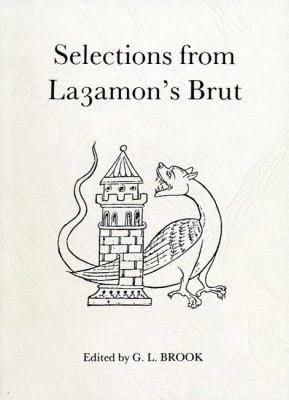 | ||
Similar Wace books, King Arthur books | ||
Layamon's Brut (ca. 1190 - 1215), also known as The Chronicle of Britain, is a Middle English poem compiled and recast by the English priest Layamon. The Brut is 16,095 lines long and narrates the history of Britain: it is the first historiography written in English since the Anglo-Saxon Chronicle. Named for Britain's mythical founder, Brutus of Troy, the poem is largely based on the Anglo-Norman Roman de Brut by Wace, which is in turn a version of Geoffrey of Monmouth's Latin Historia Regum Britanniae. Layamon's poem, however, is longer than both and includes an enlarged section on the life and exploits of King Arthur. It is written in the alliterative verse style commonly used in Middle English poetry by rhyming chroniclers, the two halves of the alliterative lines being often linked by rhyme as well as by alliteration.
Contents
Language and style
The versification of the Brut has proven extremely difficult to characterise. Written in a loose alliterative style, sporadically deploying rhyme as well as a caesural pause between the hemistichs of a line, it is perhaps closer to the rhythmical prose of Ælfric of Eynsham than to verse, especially in comparison with later alliterative writings such as Sir Gawain and the Green Knight and Piers Plowman. Layamon's alliterating verse is difficult to analyse, seemingly avoiding the more formalised styles of the later poets.
Layamon's Middle English at times includes modern Anglo-Norman language: the scholar Roger Loomis counted 150 words derived from Anglo-Norman in its 16,000 long-lines. It is remarkable for its abundant Anglo-Saxon vocabulary; deliberately archaic Saxon forms that were quaint even by Anglo-Saxon standards. Imitations in the Brut of certain stylistic and prosodic features of Old English alliterative verse show a knowledge and interest in preserving its conventions.
Layamon's Brut remains one of the best extant examples of early Middle English. During an era in English history when most prose and poetry were composed in French, Layamon wrote to his illiterate, impoverished religious audience in Worcestershire.
In 1216, around the time Layamon wrote, King Henry III of England came to the throne. Henry regarded himself as an Englishman above any other nationality, unlike many of his recent predecessors, and moved his kingdom away from the Old French dialects that had ruled the country's cultural endeavors.
Several original passages in the poem — at least in accordance with the present knowledge of extant texts from the Middle Ages — suggest Layamon was interested in carving out the history of the Britons as the people 'who first possessed the land of the English'.
Manuscripts, editions, and translations
Two copies of the manuscript are known; one in the MS. Cotton Caligula A ix, dating from the third quarter of the 13th century, and in the Cotton Otho C xiii, copied about fifty years later (though the extant, damaged, text is shorter). Both manuscripts are in the British Library.
